2020 KAWASAKI Z900 vs YAMAHA MT09: For so many years, if you wanted a reasonably priced nakedbike, you often found yourself with an ill-handling, under-braked and largely underwhelming bike. If you wanted performance close to that of a sportsbike you needed to build it yourself by tearing a sportsbike to shreds, usually resulting in an uncomfortable although fast eyesore.
Then the hypernakeds arrived and heralded the age of superbike performance in a comfortable naked package, and they didn’t look like they were designed by a blind person. But this is the exclusive domain of bikes that generally cost well in excess of $20,000. So the reasonably priced nakedbike segment simply sat there being shit, while the hypernakeds did the business, right? Wrong, so wrong.

When it comes to large-capacity nakeds, the various marques would like us to believe that you need to be spending the big bucks if you want to have fun in the nude. We found out that simply isn’t true when we put these two up against each other.
Yamaha’s MT-09 and Kawasaki’s Z900 share similarities in price and capacity, they’re both in a state of nudity and they both offer bucket loads of fun at a reasonable price. And as we found out, that’s what these two are all about – fun.
To be honest, both have seats that will encourage you to dismount before you see too many digit changes on the odo, they offer scant protection from the elements, so doing massive miles is really just not their bag. But fun, oh that they do and do very well, and it’s how they get to fun-ville that really separates these two.
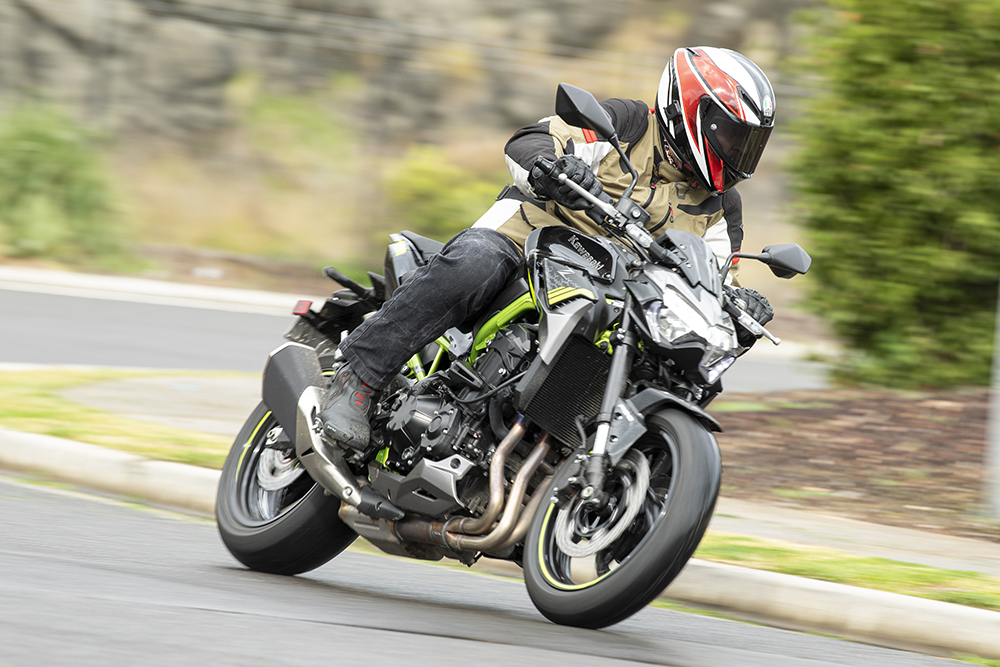
Lets talk donk. Look at them; the powerplant is the centrepiece of the whole set-up. The Zed’s 948cc inline four is smoothness incarnate, there’s barely a vibe to be found at any rpm, and it makes power from down in the very guts of the rev range and continues unabated until redline.
Switch to the MT and you’re convinced, initially at least, that the 847cc triple is packing more punch – it wants to wheelstand in the first two gears just off the throttle. But it’s not; the Zed’s mill puts out a claimed 92.2kW of power at 9500rpm and 98.6Nm of torque at 7700rpm versus the Yammie’s 84.6kW @10,000rpm and 87.5Nm @ 8500rpm. The MT feels faster because the triple’s power hits like a slap in the face where the Zed’s power is more akin to an overly enthusiastic stroke of the hair that pulls your eyelids back.
The Z900 loves a wheelie just as much as the MT, and I reckon it sits on the back wheel a bit nicer, it just takes a bit more technique to pop it up.

Once the novelty of the way the MT makes its power wears off and you’ve stopped trying to pull wheelies everywhere the police or other vehicles don’t get in the way, you can be more objective when assessing the squirt factor. The Zed’s extra mumbo showed its dominance at every green light race and roll on drag; with the Zed pulling ahead of the MT in both scenarios no matter who was riding. Both run a six-speed ’box, with the MT supplied ex-factory with an up-only quickshifter. The MT’s ’box feels pretty agricultural compared to the Zed’s, and the quickshifter has a lag to it that means if you’re handy on a manual shift you’ll get the job done just as quick.
The Zed’s box is as slick as it gets, easy and precise, but because of the engine’s versatility it requires less use than the MT’s – it’s bordering on ridiculous how low you can let the revs drop and still pull away cleanly on the ZED. I let the revs drop down to 1000rpm in sixth and still it pulled away clean and strong.
The Zed’s fuelling/throttle combo is smooth and progressive compared to the MT’s, which is abrupt in the sportiest of its three modes (A, standard and B) and requires more finesse. The Zed’s throttle response is so smooth there was no need to stuff around with modes, even in the slick conditions we played in.
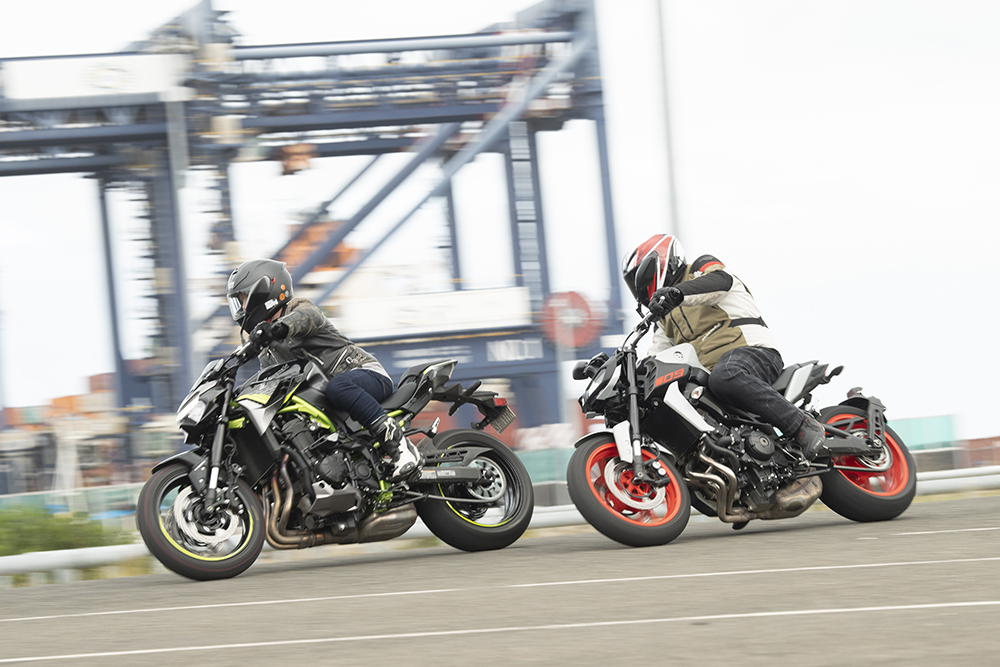
The Yamaha’s traction control can be turned off and the level adjusted with a dedicated switch on the left-hand switchblock, but ABS is non-switchable. The Zed runs three ride modes; Sport, Road, Rain and a fourth customisable Rider mode which allows you to adjust the power level and traction control’s intrusion level.
The Z900 carries 10kg of extra weight compared to the MT-09, and when you’re pulling them off the sidestand or wheeling them around you can notice the difference, and out on the road the difference is still felt. But the difference isn’t big and there’s plusses to each. The MT feels more nimble, but twitchy, while the Zed feels more planted and predictable. Obviously, this has a lot to do with geometry too, as well as weight, the MT has a steeper steering head angle and a 15mm shorter wheelbase which makes it feel a bit more active.
Both bikes started out with the factory suspension settings, the Zed’s 41mm Kayaba USD fork and back-link rear shock offer preload and rebound adjustment, and didn’t need to be touched despite a 30-kilo difference between my portly frame and Woody’s more compact chassis.
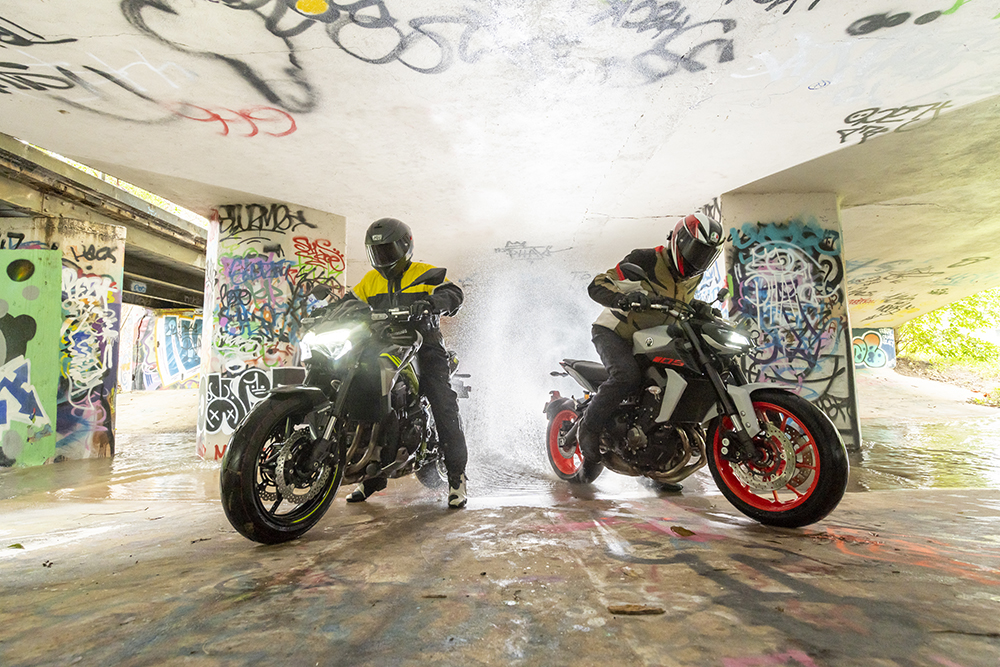
The MT, on the other hand, carries a 41mm fully adjustable Kayaba USD fork up front and a Kayaba monoshock on the bum. On factory settings the fork worked well, if not a little harsh over acute bumps, but the factory settings on the rear were way off for both Woody and I. Attempting to adjust the rear preload brought some new and colourful words into the test’s vernacular. Apart from Yamaha deciding not to give us the tool with which to adjust the shock, access to the adjusting ring is a joke. Access to the Zed’s rear shock is a little better, but again no tool! It turns out you do get a C-spanner when you buy the MT-09, but one’s not included in the toolkit supplied with the Kawasaki – go figure. Luckily I own one, and with some extra preload out back the MT turned and held a line in a far more predictable manner.
Where the Zed’s more relaxed geometry and extra weight benefits it is in the faster turns. It’s extremely stable, but not at the cost of flickability, and changes of direction are pretty effortless. There’s a bit of dive under heavy braking but nothing excessive, and it helps throw a bit of weight on the front wheel aiding the already superb feedback from the front tyre. There’s no period of having to ‘get used to it’ with the Zed, it’s just intuitive. This talk of extra weight may have you thinking big and heavy, but it’s not and the pork it is carrying is hidden well. It feels light and nimble, it’s just that in one-on-one combat with the MT it feels more planted rather than heavier.
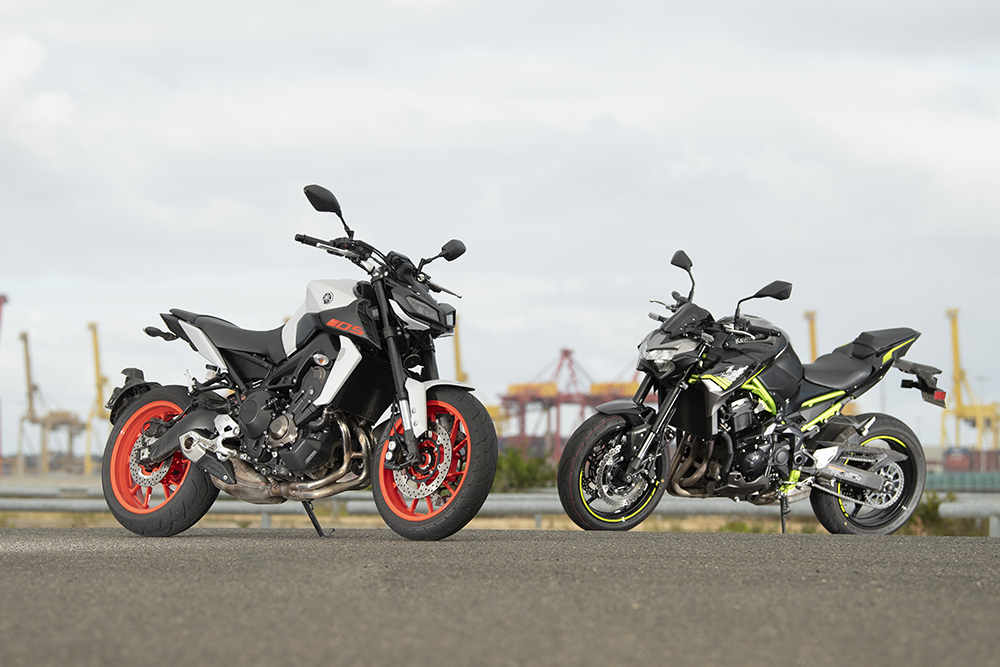
On the Zed, you set up for a corner, settle her down, drop it on its side and let its corner stability and supreme feedback help you carry high corner speed before leaning on the traction control, and using its torque to punch out of the corner on full gas. It’s all very classic riding stuff done beautifully, and getting a set of corners nailed on the Zed is as rewarding as it is effortless.
Cornering the MT is equally as fun, it’s just a different kettle of fish and for maximum grin goes a little like this: wheelie from one corner to the next grinning like an idiot, jam on the anchors, let the slipper clutch tidy up your entry a tad, square the corner off and power wheelie out the other side, still grinning like an idiot.
Sure, you can run the Zed’s cornering technique, but the MT doesn’t have the mid-corner poise of the Zed, it feels a little nervous mid corner in comparison. At times it feels like the front wheel is trying to head for the steering stops when you tip into a corner and there’s not a lot of feedback through the high ’bars which, combined with the upright riding position, reduces your ability to get weight over the front. It just doesn’t do the business in the same confident manner – and it’s way more fun doing it the other way.
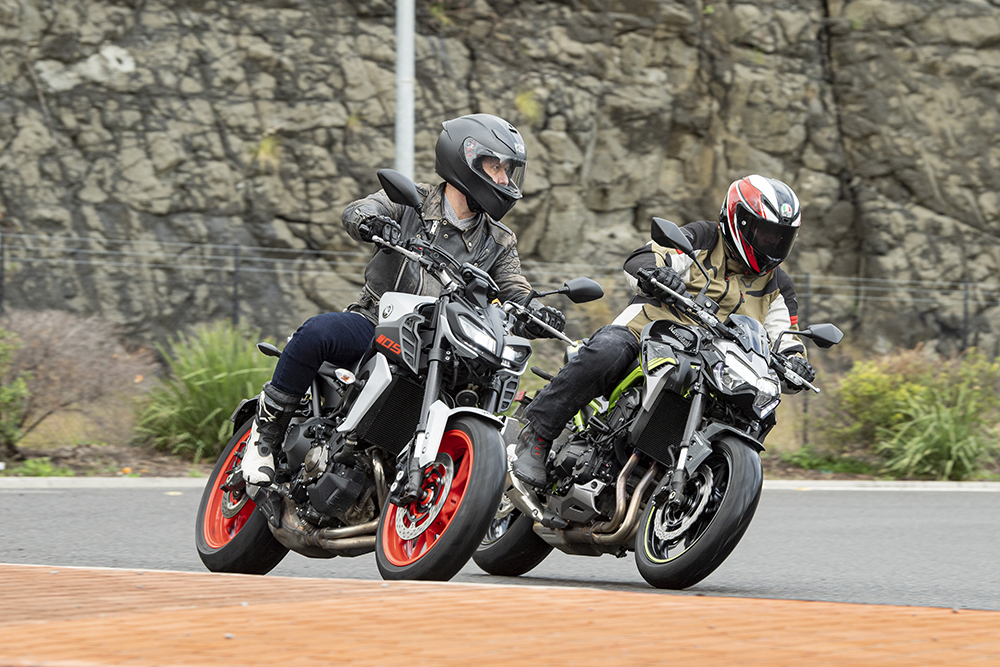
Some of the blame for the front-end nerves could be attributed to the Bridgestone S 20 hoops fitted to our test bike. Disappointingly, the rear tyre was all but finished and squared off, while the front, which appeared to be in a better condition, never felt good – especially in wet conditions.
Both run ABS-equipped twin disc front stoppers, the MT sports unbranded R1-ish looking radial mount calipers versus the Kwaka’s old-school looking versions. The Zed runs pretty petal-style 300mm discs with standard 298mm rotors on the front of the MT. Despite the different caliper types, neither Woody or I could pick a winner in the front brake department, both offer great power and feel with two finger braking being adequate for the performance on offer.
If I was asked to pick a winner (don’t laugh), I’d go with the Zed because it offers equivalent performance while pulling up 10 kilograms of extra bike. The rear braking on both is handled by single-piston Nissin calipers, but where
the Kawasaki’s setup lacked feel, the MT’s
was spot on.

The MT carries a 14-litre fuel payload, so range is limited compared to the Zed’s 17-litre jobbie, but neither bike is pretending to be a long-haul mount. The MT’s seat is a truly horrendous beast when you’ve been in the saddle for more than an hour. Initially it feels lovely; really soft and plush, but after a while you feel like you’re sitting on the subframe rails. Screaming around town, running amuck and carving through traffic though, it’s not an issue.
The Zed’s seat is firmer and it’s better over the long haul, but it will still punish your backside mercilessly if you try and ride through a tank of fuel. The Zed has a small screen which makes a surprising and welcome difference at highway speeds, without spoiling its looks, too.
Speaking of looks, the styling is very different. I prefer the design of the MT. The Zed is perhaps bordering on boring while the MT is in your face. The Kawasaki’s level of finish is better and it doesn’t have that awkward satellite-style number-plate hanger hanging off its swingarm.
At the control centre, the seating positions are surprisingly different. The MT is very upright, almost supermotard-like, while the Zed has more traditional nakedbike ergonomics, with a slight lean and stretch to the ’bar.

The 2017-model Z900 copped some flack in our test at the time (AMCN Vol 66 No 22) for its cramped leg position, but positive comments for its accessible 795mm seat height. Kawasaki has flipped that on its head and there’s now more leg room, but the seat height has grown to 825mm and the pillion seat looks like a great pew – for someone you don’t like. The MT’s one-piece seat comes in at 820mm tall and the pillion seat looks thin but far more inviting than the Zed’s high-altitude plateau.
Both bikes have a nice flat side profile with which your knees can grip the tank. My shin rested on the right-hand engine cover on the MT which could get uncomfortable once you get rolling if you’re tall (and not wearing boots).
If you’ve read my tests on the Z H2 or Ninja 1000 SX you’ll know that I’m a fan of Kawasaki’s full colour TFT instruments, I won’t bore you with the details again except to say I reckon it’s the best TFT on the market at the moment. The MT runs an LCD-style unit that’s cocked to one side and built into the headlight surround. It’s easy to read, gives you all the info you need, but everyone prefers a TFT these days.
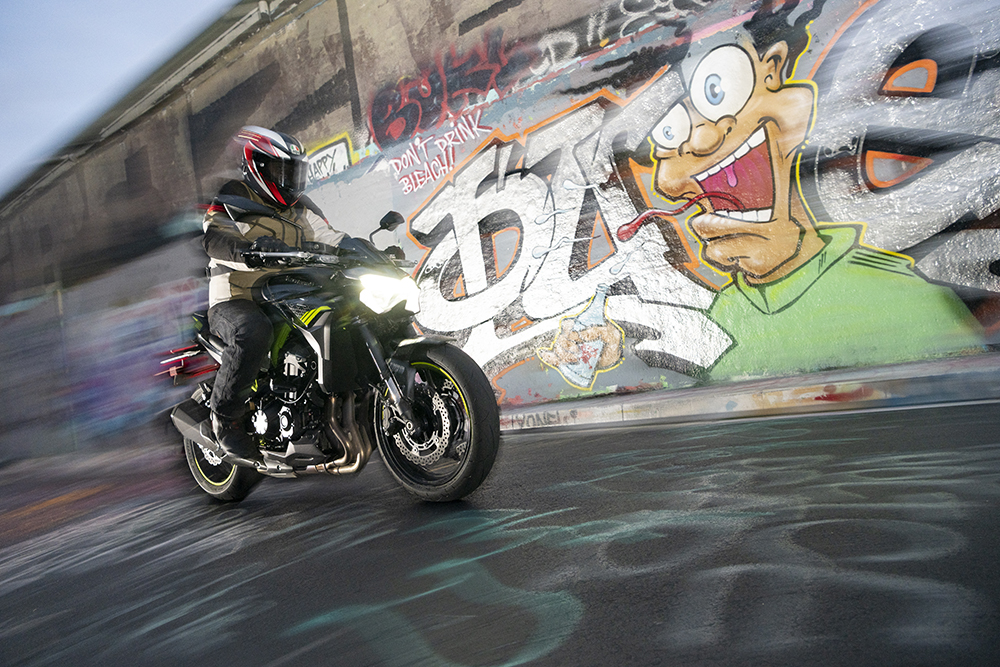
Both machines will get you from point A to point B with a maximum of fun for your dollar, they just excel in different parts of the fun-time spectrum. The MT is all hooligan, in-your-face and brash, there’s a reason why they are everywhere. It’s incredibly fun to ride, it’s got an edgy look and an engine that’s full of character.
The Zed, on the other hand, is a bit of a sleeper and may just be one of the most underrated bike available today. I don’t think I’ve seen another one on the road and, after spending the last two weeks with it, I really can’t understand why. It’s engine is as mean or as ‘pussy cat’ as you want it to be, and it handles so well I’d have a crack at any other bike at any price point on a twisty stretch.
You wouldn’t go wrong with either of these nakedbikes, and for the money they offer some of the best fun for buck you can have on a road-going motorcycle.

TEST: PETE VORST PHOTOGRAPHY INCITE IMAGES











